#ui case study
Explore tagged Tumblr posts
Text
Designing the Future: A Designer’s Insight into the Role of UI Case Studies
As designers, we're not just creating websites but crafting experiences. In this journey, UI case studies aren't just helpful; they're essential. They are our guides, our inspiration, and our lessons learned, helping us bridge the gap between aesthetic appeal and functional brilliance.

The Evolution of Web Design and UI
Remember the days of simplistic, text-only websites? We've come a long way since then. Today, UI isn't just a part of web design; it's the heart of it. It's where art meets user needs, where every pixel can make a difference in the user experience.

Understanding UI Case Studies
For us designers, UI case studies are like stories with a moral. They detail the journey of a UI project, from the first sketch to the final user interaction. These narratives are a goldmine of information, showing us the 'why' behind every design decision.
Why UI Case Studies are Crucial Today
Learning from Successes and Failures: They’re like a seasoned mentor, showing us what works and warning us about what doesn’t.
User-Centric Design: These studies remind us to keep our designs focused on the user, making sure our creations are as intuitive as they are beautiful.
Innovative Solutions: They’re our muse, offering creative solutions to the unique challenges we face in our design endeavors.
Benchmarking and Standards: They help us gauge our work against the best in the industry, pushing us to aim higher.

Impact on Business and Branding
A well-executed UI is a silent ambassador for the brand. It’s more than just a pretty face; it’s a tool that can elevate user engagement and conversion, directly impacting the business’s bottom line.
Integrating UI Case Studies into the Design Process
Incorporating lessons from these case studies is like adding secret ingredients to our design recipe. It involves iterative improvements guided by real-world feedback and data, ensuring our designs are always evolving and improving.
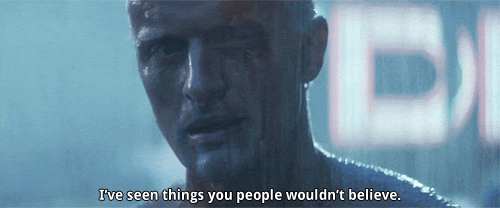
Future of UI Design and Case Studies
Looking ahead, UI design is set to become more personalized and more intuitive. As AI and immersive technologies weave into our design canvas, the role of case studies will also evolve, offering new insights into these uncharted territories.
For us designers, UI case studies are more than just a reference point; they are a source of inspiration and learning. As we navigate the intricacies of crafting digital experiences, these studies provide invaluable insights, helping us create designs that look great and resonate deeply with users.
I explored some of the case study references from one of the leading UI/UX agencies in the USA- Pepper Square, and I've mentioned it above.
Please add more in the comments if you find more.
1 note
·
View note
Text

...
#i did not mean for the trend u see happening her to occur i really did not intend this#also yall might hate me for putting Misha/Mikhail here but the kid is truly beyond help#i wish it were different but this child cannot be saved the damage has been done it is over for his sanity#there is no coming back for this kid like even ui ui has a better chance at sanity than this train wreck#the damage has been done y'all there aint no fixing him fr fr#get in loser#wer'e going straight to jail do not pass GO#anime#anime memes#jjk#jujutsu kaisen#jjk memes#mei mei#misha vnc#mikhail vnc#vnc mikhail#vnc#hisoka#hxh#hunter x hunter#vanitas no carte#the case study of vanitas#naruto#naruto memes#orochimaru
79 notes
·
View notes
Text

Rando Loops: Optimized Experience & Animations Update
#Rando Loops#UI Design#UX Design#Motion UI#Interface Animation#Smooth Interactions#App Update#Design Evolution#Playful UI#Mobile UI#Game Design#Dribbble#Creative Process#UX UI#App Experience#Interaction Design#Digital Product#Visual Design#Microinteractions#Mockup#Case Study Coming Soon
0 notes
Text
#ui/ux#ui/ux design#ux design#ROI of UI/UX#UI UX Case study#Website design#User Experience (UX)#web development#website UI UX
0 notes
Text
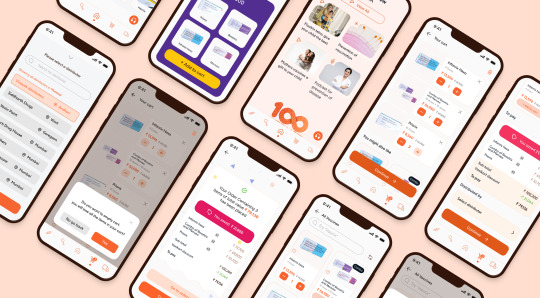
Imagine being an HCP, working in a high-pressure environment where time is of the essence. You’re responsible for ensuring your patients have access to life-saving vaccines, yet the process for ordering them remains stuck in the past. Paper orders, phone calls, and face-to-face interactions were still the norm — methods that, while familiar, were time-consuming and inefficient. GSK had developed an app meant to modernize this process. But when HCPs first began using it, the feedback was overwhelmingly clear: the app was clunky, unintuitive, and difficult to navigate. Out of 11,000 potential users, only 3,000 HCPs gave it a try, and even they quickly reverted to their old habits. The app, intended to simplify the process, was actually creating more barriers. As a result, vaccine sales plummeted by 70%, severely affecting accessibility. My role was to reimagine the experience from the ground up, with the HCP’s needs at the core. I had to understand their daily challenges — fast-paced environments, limited time, and the need for a seamless workflow. By diving deep into user feedback and studying their pain points, I began reshaping the app into a tool that would fit effortlessly into their workday, rather than disrupt it. The goal was simple: make the app as intuitive and accessible as possible, ensuring that HCPs could easily order vaccines with minimal effort. By focusing on usability and streamlining the interface, we aimed to increase engagement, sales, and, most importantly, vaccine accessibility. This project was not just about fixing an app — it was about empowering healthcare professionals to better serve their patients by giving them the tools they needed to do their jobs more efficiently. And in doing so, we were able to turn things around, increasing both sales and usage, and ultimately improving the availability of essential vaccines.
#ui ux design#design#appdesigners#vaccines#pharmaceutical#get vaccinated#mnc#case study#user interface#business#customer experience#profit#omnichannel
1 note
·
View note
Text
Case Study : Redesigning Kingdom Hearts for Mobile Gamers
Context
Video games should be a universal experience, but increasingly, older gamers find themselves isolated from it due to games' lack of accessibility.
Kingdom Hearts is an action role-playing game developed by Square Enix and released on the PlayStation 2 in 2002. The game features an action-oriented battle system, a role-playing leveling system, and a few smaller mini-game sections between worlds. For the redesign, the plot will not be affected by any changes. However, it would be made more for users to play on the go for a quick burst or while sitting and relaxing at home for a longer more, “system-like” play.
Objective
Redesign the UI of a nonmobile game, Kingdom Hearts, into a mobile gaming experience accessible to elders.
Implementation
Menus

| Pause Menu
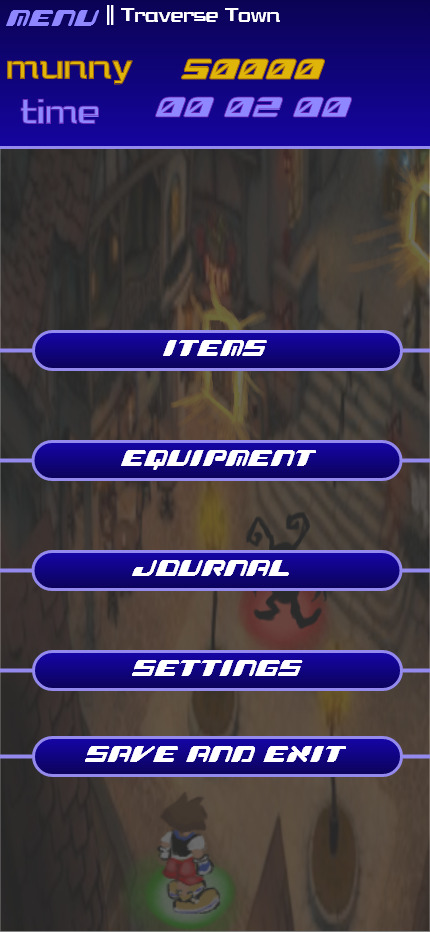
| Redesigned Pause Menu
Menus would be streamlined in the gaming process so that the elder player can spend more playtime in-game rather than in menus. Many of the previous menu options are now automatically added to the player (upgrades and abilities) or are not needed anymore (status and customize).
Exploration
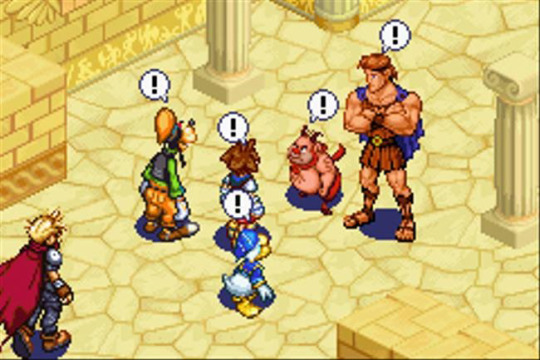
| Kingdom Hearts: Chain of Memories Isometric Camera

| Redesign UI camera and main UI
Originally, Kingdom Hearts used a 3rd Person camera that is known to be very floaty, difficult to control, and overall unresponsive. For the redesign, the camera would be isometric and follow the character as it moves. For an older player, I wouldn’t want them to have to think about the camera in any way or move it. This type of camera was only used one other time in the series for the title Kingdom Hearts: Chain of Memories for the Gameboy.
The player character, Sora, has a glowing green dot under him for visual contrast and so he is more noticeable to elder players especially if other characters or enemies are on screen. Enemies in the game have a red spot under them and they stand in one spot, unmoving, unlike the original game.
Within exploring the game world, there would be a color system for doors. If a door leads to another accessible area it would glow: Red for boss areas and gold for normal areas. This change was because the original game has a lot of painted on doors for textures and I wanted the player to be clear on where they can go.
A mini-map would be added to the game, to assist navigation. Though the first game lacks one, this was later corrected in newer entries. Some areas of Kingdom Hearts are known to be hard to navigate and I believe this quality-of-life change will help a lot with navigation. On the mini map, doors are marked either gold or red just like in the overworld. The player is also marked with a green dot. The mini-map will also be stagnant and not move.
World Map and Gummi Ship Minigame

| World Map
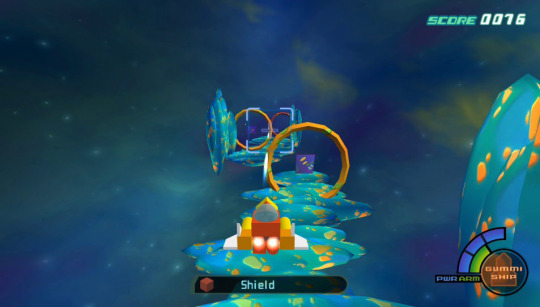
| Gummi Ship Mini Game

| Redesigned world map
For these two sections, there are no major changes because they are already simple and straightforward.
For the world map, I only changed the way the battle level is displayed, I used numbers out of 10 instead of the star system because I believe it’s easier to understand. The only change I would give gummi sections is making them shorter, making the HP and MP bars like the new battle ones (introduced below), and giving the ship automatic upgrades instead of having to build and add them yourself because, in the original game, this system is confusing and unfun.
Battle System, Magic, and Item Change
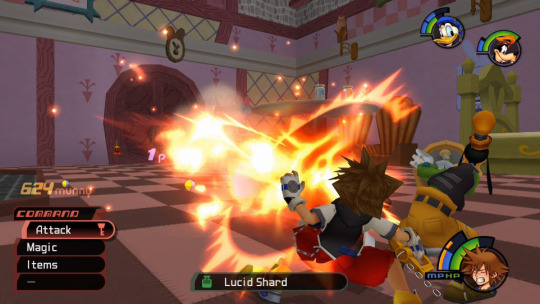
| Standard battles in Kingdom Hearts
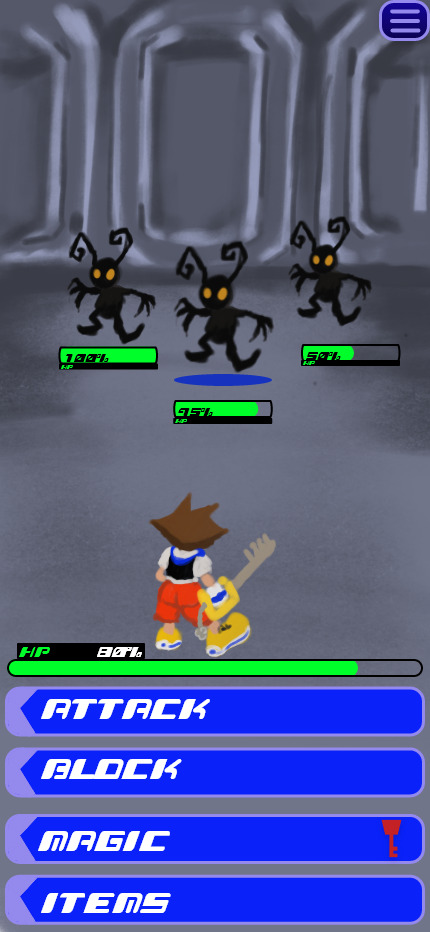
| Redesigned Battles (showing Health Points)
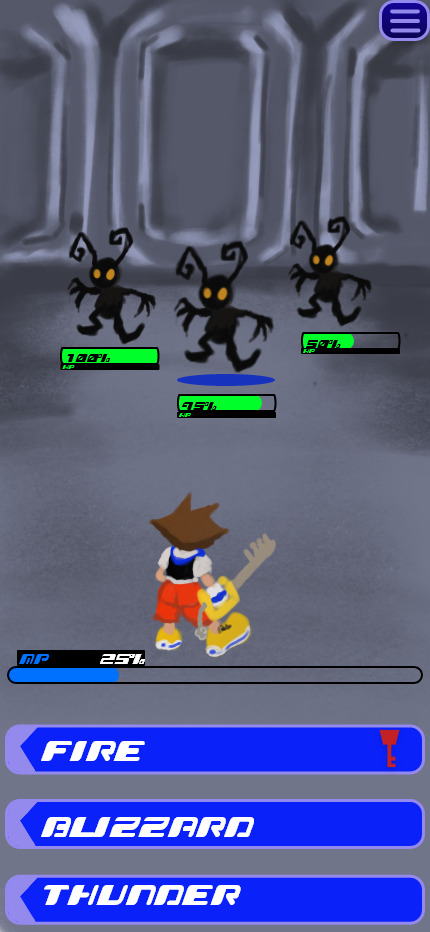
| Redesigned Battle (showing Magic Points)
To make Kingdom Hearts more accessible and easier on a mobile format, I decided to change from an action battle system to a turn-based battle system. Action games require quick reflexes and timing, two things that decrease as a person ages, however; for a turn-based game, the player will not have to worry about reaction times or reflexes, they may take as long as they like to go through battles. The camera during this section would not change, only the characters would move.
Health Points (HP) and Magic Points (MP) would be displayed differently. Instead of the radial style used in the original, I opted for using bars for a simpler look. HP will display directly under the player character in most menus, only when clicking the "Magic" menu will the bar change to show the player's MP. This change is to help with managing the different point systems so the battle UI is not cluttered. Number percentages would be added to both bars to help with understanding the number of points left. For enemies, the HP bar will always be shown under the enemy and will not need to be unlocked like in the original game. Under the enemy that’s being targeted, a blue circle will be shown. For each battle, HP and MP will replenish back to 100% for the player.
To adapt to a mobile format, made changes to the command menu that Kingdom Hearts uses for battles. Instead of having to scroll through and select, the player can simply tap the button for attacking, blocking, magic and items. Within this I also made a change to items used in battles, only three would be available to players: Potion (for healing HP), Ether (for healing MP), and Antidote for status effects. All status effects would be able to heal with Antidote instead of having different items for statues, this makes item management much simpler for an elderly player.
The magic system now lists all the magic available and automatically upgrades to the stronger version of the spell instead of having to equip it, taking away the need to prep outside of battles and streamlines the playing experience.
The party system would work similarly to other games with the party member characters attacking/healing/blocking on their own however I would like the party members to be programed to heal the player character’s health or magic more often than themselves so that it’s less that an elderly player would have to worry about, and they can focus on attacking the enemies.
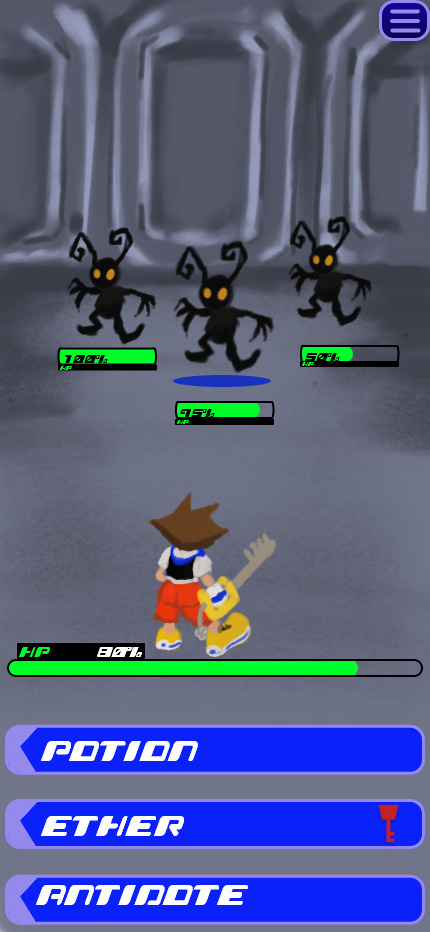
| Redesigned Item Menu
#ux#ui#ur#portfolio#ui ux design#kingdom hearts#case study#kingdom hearts redesign#user experience#user interface#user research
1 note
·
View note
Text
The ROI of Great Web Design: How a Smart Website Boosts Your Business
There's a secret weapon for boosting your online success... and it's not what you think! Discover the power of exceptional web design in our new eBook.
In today’s digital age, your website is your storefront to the world. But is it a thriving marketplace or a dusty forgotten corner? This ebook, written by Mwenya Chongo, CEO of Mukwood Digital Web Design Studio (registered in Zambia), dives deep into the power of well-crafted web design and how it directly impacts your business’s bottom line. Uncover the hidden potential of your website and…

View On WordPress
#affordable web design#best web design companies#branding#Content Marketing#conversion rate optimization (CRO)#digital marketing#domain name registration#ecommerce website design#email marketing#graphic design#information architecture#landing page design#logo design#mobile-friendly web design#responsive web design#responsive web design cost#ROI for web design#search engine marketing (SEM)#SEO cost#SEO web design#social media marketing#user experience (UX) design#user interface (UI) design#web analytics#web copywriting#web design#web design agency#web design case studies#web design for non-profits#web design for small businesses
0 notes
Text
Portfolio case studies describing design, my UX process, and the business impact.
From boosting user adoption in fintech, to improving trust with responsible gambling through to retaining Millennials in the world of digital lotteries UX to leveraging key USPs for mobile healthcare.
More Case Studies | Quick-Look PDF
#ux#ui#gambling#mobile#brand#userexperience#uxdesign#healthcare#super app#open banking#money management#UX discovery workshops#high net worth#dark mode#fintech#case studies#ideation#customer journey map#mobile ui#UIdesign#identity design#logo design#ios split screen#ipad#lottery#illustration#branding
0 notes
Text
0 notes
Text
Digital Innovation at Its Best: The Finch Design's UI UX Overhaul for Hindu Yuva
Explore The Finch Design's radical revamp of the Hindu Yuva website, a non-profit organization for Hindu youth in the United States. Our UI/UX overhaul improved aesthetics, navigability, and brand communication, enhancing user experience and fostering increased engagement. Discover how our design decisions resonated with the tech-savvy youth, conveying Hindu Yuva's core ethos with clarity and visual appeal.
0 notes
Note
Reading glasses Simon.
Reading glasses Simon.
fluff and nsfw (my first crack at nsfw ever so pray for me). dividers from @gild-ui! CW: fem!reader, fingering (fem receiving), oral (fem receiving)

Simon doesn’t need glasses for day to day life - his vision doesn’t impair his job. but, when it’s getting dark out and he’s picked up a book he’s been meaning to read? he’ll break out a pair of reading glasses
he doesn’t wear them around you for a while, not out of shame or embarrassment. when he first started dating you he simply forgot about the book sitting on his dresser, he was too busy with you to pick up that dusty, thick book
but once you’ve settled into your relationship? you come across him one night after a shower, a sleek, black pair of reading glasses resting over the bridge of his crooked nose. they aren’t fancy, just something to get the job done
but they’re so charming against his scarred face, a perfect match with his stubble and short-cropped hair. and when dark irises, nearly black in the dim lighting of the bedroom, look up at you behind those lenses? it’s enough to make your knees go weak
Simon insists that he only uses them for reading, he can see your pretty face just fine. he’s got a roughed up, black case for them - neatly tucked into his bedside table. he wouldn’t say it out loud, but he loves seeing you walk around with his glasses on. he doesn’t care if you nab them from his bedside, he’s too busy admiring you
he’s had the same pair for three years, lost the last pair on a deployment - he doesn’t bring them with anymore. he smiles when you offer to buy him a new pair, but he shrugs it off, “S’fine, don’t have a reason to get new ones, love.”

at night, when the stars and city are closed out by thick curtains, Simon loves settling down with you in bed. after a life of not receiving love, these little intimate nights make his heart squeeze with adoration for you
while you’re unwinding, phone in hand, Simon has his book. reading glasses idly resting on his nose, he can’t help but glance your way - eyebrows slightly knit as he studies you. taking in your relaxed shoulders, steady breathing, the slight upturn to your lips as you smile at your phone
he can’t help it when he moves his hand under the covers, eyes going back to the page he was reading. rough hand settling on your thigh, he gives it a small squeeze - innocent
but when his hand shifts down towards your core, pointer and middle finger grazing the edge of your underwear, his loving touch becomes a little more intimate
thumb smoothing over the skin between your hip and thigh, his fingers dip past the thin material - all the while he’s still reading
just when you’re about to question him, playful smile tugging at your lips, his middle finger dips down - touch light as he rubs at your clit. any words that you had die on your tongue as you shift your hips
“Don’t let me distract you, lovie.”, he hums, voice gravely as he flips a page, “Go on, keep lookin’ at y’phone.”. he cracks a small smile when he hears a little whine from you, finger pressing a little harder, tight little circles against you as he keeps his gaze down - he’s read the same line about three times
he doesn’t care when you set your phone down instead, canting your hips up slightly to meet his touch. he can’t help it, soon enough his hand is dipping past your underwear - the heel of his palm pressed to your little pearl, his ring and middle finger simply smoothing over your lips
he has to bite his tongue, cheeks heating up a little when he feels your slick - as much as you feel good, Simon’s getting off on just feeling you, his pretty little thing that loves him unconditionally
and, as a man that thrives off acts of service, he can’t help himself when he dips his middle finger into you. the soft gasp that leaves you falls on deaf ears, his own groan rumbling in his throat as his eyes flutter shut
he’s holding back a little, gripping his book a little too hard while you squirm - as much as he loves making you feel good, he’s a little selfish. he’s a little greedy, doing this more so for himself. and if greed is a sin, then he’ll atone by worshipping your body
bending the top corner of the page he’s on, Simon’s quick to close his book. halfheartedly shoved onto his bedside table, he turns his focus to you - your legs a little twitchy and lips parted as he dips a second finger in, “Look at you, doing so good f’me.”. low, murmured words as he leans over, pressing a quick kiss to your cheek. a small, gruff chuckle leaves him when he pulls his hand away, hearing you huff out a complaint. he’s quick though, one last kiss to your jaw before he’s pulling the covers back, “Don’t worry, love. I’m not done.”
moving to sit between your legs, he brings his fingers up to his mouth - a low moan rumbling in his chest when he tastes you on his digits
true to his word, Simon’s not done with you. reading glasses still perched on the bridge of his nose, he shifts to lay down against the sheets. moving your legs so your calves rest over his shoulders, he looks up at you, “Gonna be good, doll?”. a genuine smile on his lips when he hears you plead for him, and who’s he to deny his darling?
pressing a kiss to your clothed cunt, he pulls your underwear to the side - left hand holding your thigh while his right holds the thin fabric to the side. he loves this - the sight of you flushed and pretty for him, looking down at him. it makes his stomach twist with need, a warmth settling in his gut as he leans down
“Course you’ll be good f’me—“, he hums, lips pressing to your clit as he closes his eyes, “Always such a good girl f’me, aren’t you?”, he mumbles against you, deep voice dripping with love. eyebrows pinched as he groans, gently lapping at you as he presses his hips to the mattress. “Pretty little thing, always treatin’ me right.”, holding you a little closer to him as he grinds down against the bed
hearing your sweet gasps and moans sets a fire in him, and when your hands find their way to his hair and tug? sparks fly, a whine of his own resonating in his throat. despite his quiet demeanor, his reserved nature and curt sentences in public, Simon finds his voice in bed
grip firm on your thigh, his mouth settles against your cunt - thumb moving to your clit again, “Wanna see you cum, lovie—“, he murmurs, drowning against you as his hips writhe
you’re not faring any better, hands rooted in his dirty blond hair. between his hold on you and his mouth - his thumb making quick circles, it’s all too much. and when he glances up at you from between your slick thighs, reading glasses fogged up and slanted? the tight, drawstring tension in your stomach is close to snapping - Simon’s not letting up as he moves his left hand under your shirt
can you blame him? sweet moans tumbling from your lips and thighs squeezing around his head, his hand settles over your tummy - gentle, careful pressure as he holds you down. Simon would have a pillow under your hips if he hadn’t been in such a needy rush, but he’ll just do that next time
eyes half lidded as he presses a kiss your thigh, he’s diving in again - lips and chin soaked. he knows you’re close, so is he, the fabric of his sweatpants and the friction from grinding against the mattress pushing him to the edge. but when you give a sharp tug of his hair, thighs pressing against him a little too tight, he feels the temple of his readers snap
disconnected from the hinge, the right side of his glasses break and so does Simon - sweatpants ruined as he pushes two digits into you, loud moans tumbling from him as tries to push you over too
it’s not long before you’re following after him, your heels digging against his back as you ride out your orgasm. Simon doesn’t quit though, not yet - lets you ride it out against him, grinding your hips against his mouth, not that he minds
breathing steadying as a moment goes by, Simon gently moves out from between your thighs, a kiss pressed to each knee before he’s moving to the bathroom. a warm, wet towel in hand he walks back, leans over to press a kiss to your forehead, “Did so well for me.”, he hums, a soft smile on his lips as he gently cleans your thighs. the mattress dips with his weight as he settles back into bed, towel dropped to the floor - he’d get it in the morning
broken readers left in your shared bathroom as Simon holds you close
#I’ve never written this before so I hope it’s good lol#ghost#simon ghost riley#simon riley#ghost cod#ghost call of duty#ghost x reader#simon ghost riley x reader#simon riley x reader#simon riley x you#ghost headcanons#simon riley headcanons#hit post
836 notes
·
View notes
Text

;R1999 - Self-Aware AU

Headcanons about an Alternate Universe in which everyone knows they're living inside a videogame. However, Vertin is the only one aware of the entity inhabiting her own mind, the real conductor - the "Player".

this is one of my favorite AUs to slap on whatever media I'm into so here we are <3 not sure if anyone's done this already, but PLEASE PLEASE PRETTY PLEASE link me if you've seen any other ppl write for this AU! this one and any actor AUs are my absolute fave
this is just a word vomit introduction for fun, to get the basic ideas out of my head, so I can start writing for characters individually!

Okay, okay! First of all, some context for the AU before I go deranged overexplaining my HCs!
Aside from the "Storm", there is something else that haunts the people of this world: the fact that their lives are nothing but a simulacrum, part of a game.
The requirements to obtain this "self-awareness" is unknown. Those within the Foundation believe it's related to their respective "roles", that only the main and relevant characters are given the chance to fully open their eyes to the truth. Those within Manus Vindictae claim that one must be strong enough to break through the fog of complacency and their assigned scripts, to have their full potential unleashed and obtain true liberation. Either way, similar to the "Storm", this is a well-kept secret for a very good reason - everyone wants to have the upperhand.
There is one outlier to this whole system. Vertin is not only aware of the truth of this world, but also of her duty as the eyes and hands of the "Player". She must experience it all for their sake. Or rather, whatever she experiences will be the story that the Player will see.
This applies to her suitcase, the place where the Player's influence increases tenfold, bending everything and everyone to their will through her own body and voice. The longer one stays within her suitcase - or within her general vicinity - the easier it is for them to become self-aware.
How does one become "self-aware" and what does it entail?
The requirements and the catalyst for a character to become self-aware are still a mystery. But that's mostly because I specifically wanted to keep them as vague as possible, to allow some flexibility for NPCs and other characters outside of Vertin's suitcase.
The whole process of gaining sentience or self-awareness is mostly described as waking up from a nightmare, or a very, very realistic dream. It's like a switch, something that happens in a second without any warnings whatsoever.
I like to think that most of the people who wake up are easy to spot, because it's a jarring experience and panicking is the most normal reaction - but that they're often taken care of by the Foundation or recruited by Manus Vindictae.
The levels of awareness also depend heavily on each individual - some only know that nothing is truly real, that everything they've done up until that point was just a carefully scripted lie, the most basic realization. Others can understand the rules that govern this game and use them to their advantage, either through observation and study or just inherently.
Overall, the experience of being sentient varies as well, with some describing a disconnect from their body, while others feel exactly the opposite. Again, keeping it pretty vague so that people can fill in with their own ideas!
I'll talk about Vertin's case in detail when we get to her specific bullet point, but the same way the Player is able to experience the "story" through her eyes, she's able to see the same things they do - this includes the UI, the menus and everything you can interact with in-game.
Vertin as a character and a vessel for the Player.
The most common thing I've seen in self-aware AUs in my years of fandom is to turn the player stand-in (the main character that serves for the player to experience the story through and/or project onto, depending on the genre of the game) into an obstacle, one that keeps the characters from truly interacting with the Player, capital P.
The second most common thing I've seen is to simply ignore the existence of this player stand-in and replace it with the Player themself, either through isekai methods or thanks to the customization the game allows, etc etc.
When it comes to Vertin in this AU, I know I want her to retain her role as the center of everything, instead of being sidelined by the Player. She's THE Timekeeper, after all.
There's still some details I'm trying to iron out, like whether she's always been self-aware or if she became self-aware at some point during her childhood at the St. Pavlov Foundation. But I like to think that her relationship to the Player is a parallel to her immunity to the "Storm" - neither of these two things are inherently good nor bad. Surviving the "Storm" is helpful, sure, but it's painful for her. Having an entity like the "Player" haunting her is scary, sure, but it can be an advantage. It's a matter of how she utilizes the assets she was given, since her adaptability and determination are big aspects of her character. Vertin makes up for her mediocre arcane skills with unconventional plans and strategies.
But this isn't to say that Vertin isn't affected by the presence of the Player. Ironically, she's the one person whose freedom is limited. During battles, her skills and Tuning are available to you, they can also prove to be vital to win a fight, but in the end you're still the one calling the shots and choosing when her friends get to attack. You're the one choosing the layout of the Wilderness. You're the one picking which one of her friends deserves to become stronger.
In the last bullet point I mentioned that some characters can understand the rules of the game - Vertin is the most extreme case, as she can see the same UI as you do. She learns the way you like to fight your battles, your own strategies, she can see this and more.
Overall it's a very complex dynamic. It's not as easy as saying that she likes or dislikes you, that she considers you a friend or foe. You're part of her, you influence each other in many aspects and are stuck together for reasons she can't even fathom. While you may be able to read her thoughts most of the time, she becomes invisible once you enter the suitcase - the main menu of the game. Sure, the character you selected to greet you every day is actually talking to her, not you, but she's out of your view and therefore, out of our range. That's when Vertin wonders the sort of person that you are, if you care about her friends as much as she does. Are you playing just to be entertained? Are you invested in these events? Will you be there for her until the end of her story?
Another detail I like to think about is that Vertin is the only one who knows your name. Because at the very beginning, you were asked to input a name and she was there.
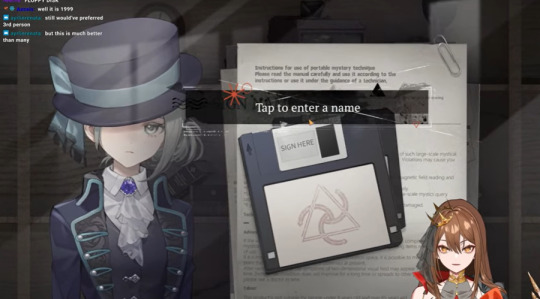
[screenshot was taken from this video, since it's the first one I could find that showed this specific part of the game lol]
Well, "your name" not quite right - she knows that whatever you wrote there is the name linked to your account, at least. And that's the name she knows you as.
Those who take residence in Vertin's suitcase or spend prolonged amounts of time with her, growing closer to her and all, end up becoming self-aware. This is a direct side-effect of your presence.
I like to think that characters who reach the 100% Bond can begin to sense the Player, to see the world in a similar way as Vertin does. Maybe even feel their presence EXACTLY like Vertin does whenever there's a battle. There is someone else on the other side of this screen, the fourth wall, who watches over them.
To some, it's hard to differentiate Vertin from the Player, as they just go hand in hand - but Sonetto, for example, has the easiest time telling the two apart.
On the subject of freedom and acting out of script.
The Foundation, Manus Vindictae, Laplace... It doesn't matter if they're self-aware and acting outside of what their script dictates, because they're missing one key ingredient: you. No one else but Vertin and her group knows about your existence, after all.
They don't know that the only story that matters is the one that Vertin is part of. The one that the Player gets to see and read and experience. And because the game gives you a very limited view into the lives of these characters, you don't know what neither Arcana nor Constantine do behind the scenes. You and Vertin don't see that, therefore, it never truly mattered.
Those most likely to start "acting out" are the troublemakers within Vertin's suitcase. Characters who are too curious for their own good, who are more susceptible to supernatural entities, who are just too impulsive - they would start to test the limits and see how far they can go, how much they can interact with the Player. Can the game be broken should they end up shattering the fourth wall? Is there a way for the Player to communicate with them? What will happen to Vertin?
I like to think that Vertin probably supports this, as she's rather curious herself, prone to questioning everything. She would also like to learn more about the Player, to truly tear into the game and see the full extent of your influence and her freedom.
Sometimes, Regulus and X will change their usual voicelines, just enough to be noticeable if one pays enough attention. Characters like Sotheby or Leilani might slip up and address the Player, rather than Vertin. Lilya, Pavia, Bkornblume have new animations and different expressions, ones you've never seen before - they stare ahead, as if searching for something, and then smirk or hum to themselves, deep in thought, like they realized something you're not privy of.
Sometimes, if you leave them as your selected assistant on the main menu, you can catch them muttering to themselves - idle quotes you never heard enough, about the outside world. Diggers does this the most, it's almost embarassing how easy it is to catch him talking nonsense, followed by Sonetto. If you leave Medicine Pocket alone for too long, you might come back to a screen covered in weird scratch marks.
On the subject of these characters being curious about the outside world and all, I think that a good chunk of them are generally content with the way things are?
We have to remember that in-universe, they're arcanists displaced from their respective eras. Their best chance at surviving is siding with Vertin, and if Vertin is content with the way things are, then there's no point in trying to disrupt what they have right now. They're curious enough to prod, but only as far as Vertin allows it.
And I think that's it for the word vomit!
There are some details I didn't know where to fit in, like the possibility of the fourth wall slowly dissipating the more time the Player invests in the game, leading to some characters being able to directly hear you if you talk while playing and whatnot. Or what would happen should someone outside of Vertin's suitcase figure out the existence of the Player, let alone interact with you in some way.
Or the concept of death being meaningless, unless it was pre-established by the game itself.
In Borderlands, there's this game mechanic where you can just be revived over and over and pay a percentage of your money as a fee, even though the canon that's established is that you play through the whole story without dying a SINGLE time - because the revival mechanics aren't canon. There's the divide between story and gameplay. That's pretty much the standard. But what about the deaths in battles in R1999? The amount of times I died to 1.3's UTTU's Flash Gathering is insane. How do self-aware characters feel about this, now that they know that they're bound to die over and over and be brought back because you have to do your Pneuma Analysis or reach the final stage of Limbo?
But that's pretty much it for now, I think I got most thoughts out of my system! Thank you for reading!
#reverse 1999#reverse: 1999#reverse 1999 x reader#self aware au#'mod six what are you going to do with this AU?'#probably write more reader inserts for FMN and pavia lmfao#i just wanted it out of my brain and onto a post#i like to think about things in-depth but thats it#and just like the hanahaki nsr au. feel free to fuck around with this concept! discuss it or make up your own HCs!#tag me if you wanna bc i love to read. but no need to credit me
404 notes
·
View notes
Text
Confusion & Suggestibility
so i had a fun experience in voice chat today! there’s this discord activity called blazing eights that is basically just uno— bear with me, i promise this is hypno-related— and myself and a couple friends were all playing it. one of them, who we’ll just call PK, played one of those “change the colour” cards and couldn’t figure out how to actually use it, because the UI for this game is really weird and bad. PK had already timed out of being able to choose the colour once, so they were a little frantic, rushing to figure out how to do it before the game just chose it for them
so at this point another one of the people in the game, who only had one card left, jokingly said “make it green,” since, y’know, that would have won them the game! PK actually laughed at this, so i know they heard it in the moment. and then they figured it out, finally realised how to actually choose the colour, and then they… made it green. it actually took PK a couple of seconds to realise what they’d done, and at that point, the other player had already won. it was pretty funny!! they very incredulously asked “WHY DID I MAKE IT GREEN??” since they knew full well that doing so would make them lose the game. we all laughed about it, because it was funny in the moment, but then i got to thinking about it. you can probably tell based on the title of this post where i’m going with this!
this is, funny enough, a very useful case study on how confusion and shock inductions actually work. it’s kind of the perfect real-world demonstration of it! PK was confused and occupied, frantically trying to figure out how to play the game properly, and when they heard essentially a direct order, even a joking one, they really didn’t pay it any mind. but once they had cleared up the thing that was taking up their brain space, their brain sort of “loaded in” the thing they had heard, and before they even realised what they were doing or processed it fully, they just… obeyed. the command slipped past their critical thought and took effect before they could actually think about it, because it was slipped in while they were confused and frantic
you can apply this principle in a lot of places, the classic rapid induction being one of my faves! we’ve all seen the jerk the arm and shout “sleep” thing, and it really works the same way. the subject is dazed and confused by the sudden physical sensation, and while they’re in the midst of processing that, trying to figure out what just happened to them, and reorienting their kinesthetic sense, that command hits first, and just like PK did, they obey before they have the chance to think about it. a deeper part of them obeys, really! the command passes right through the critical, conscious mind and vanishes into the depths of thought, which just follow it uncritically
and a lot like PK, by the time they realise what they did, it’s too late. they’re already asleep, or have already lost the game. it’s such an interesting induction tactic- and obviously, such a hot one. just having a command slipped past all your faculties, giving you no choice but to follow. you don’t even get the chance to think about it. you’re just gone…
and that’s really it!! a fun demonstration of how confusion inductions work happened before my eyes, and it’s been plaguing my thoughts ever since. can you really be sure your thoughts are yours when new ones can be forced in so easily? <3
172 notes
·
View notes
Text
I played Strange Horticulture on my Switch, so here’s a few thoughts in case anyone was considering it.
Overall, it was a fun game that I would recommend for anyone who enjoys riddles, though there are also a few puzzles. I spent maybe 8 hours total, probably less. There are multiple endings, and it’s not easy to memorize any solutions, so it can be replayed several times. Overall, I’d say it’s worth the money to purchase.
You spend the entirety of the game in your shop, which is a greenhouse with numerous rare plants. You begin with several unidentified potted plants and a book to help you identify a few based on botanical notes from the prior owner of the shop. The first few days gradually acclimate you to the UI, how to handle customers, “travel” (which is just picking a spot on your map and reading text about what you encounter), negative consequences for wrong IDs, and so on. As the game progresses, you receive letters and clues from friends and customers about where to find more plants or reference pages for your book. You must solve the riddles to determine the right spots on the map to explore. Guessing incorrectly for plant IDs and on your map will accumulate dread, which could drive you to insanity, and you must solve puzzles before you can return to the main game. There is also a story that unfolds over the course of a few weeks, and your choices about what plants to give to different occult factions will affect the ending.
The game has some clever riddles in there, and it stumped me a handful of times. As long as you remain open minded about the various tools at your disposal, you should be able to get through the game without external help. It also helps to stay organized; you can attach labels to plants for any info you want handy, and you can sort your tools and letters in a side drawer, as well as archive any items that aren’t useful (and bring them back out of course).
There are a few downsides to the game. There’s only a specific script of customers that will come to the shop, so while you may forget which plant is which in a new game, it’s mostly same requests every play through (with a few unique ones if you choose certain factions). Many of the plants are only needed once, which can be a little disappointing given the effort to ID several of them. A longer game with some filler days so you can have that “aha, I know just the plant” moment would have been satisfying.
In addition, the UI is not designed for small screens, and the text can be very small, so you will probably make heavy use of the magnifying glass to zoom into the various parts of the screen. It would have been a good idea to have the UI switch between screens (a shop counter, the garden, desk/study, etc.) rather than put it all in a single screen. Because of this, I would recommend playing on a computer screen rather than a handheld device or TV.
Otherwise, Strange Horticulture was an enjoyable game. It’s worthwhile for anyone who enjoys riddles and puzzles.
22 notes
·
View notes
Text
The Art of Asset Reduction: VNConf 2024 Write-Up
youtube
This is a write-up for my Visual;Conference 2024 talk on asset reduction: presentation of scenes with reduced art labor.
I will discuss how to reduce production requirements via various methods of asset presentation and staging, walking you through case studies of existing visual novels. This talk will guide you to answer the question: How do I fulfill my project scope without asset bloat?
This is an art talk that assumes you have already scoped down your story and have created a list of scenes that you need. This is not a talk about scoping down your game's story.
You have scenes you need to make. How are you going to make them (and with style)?
Abstraction
Cut-ins
Reduce
Reuse
-
I. Abstraction
I start off with abstraction as a reminder that visual novels are a combination of visual and novel (amongst other aspects)
Abstraction
Abstraction is a strong tool for bringing focus to the writing, highlighting ambiguity and setting the mood with colors.
Examples I mentioned in my talk include:
Black screen
Solid colored screen
Sky BG
Of Components
The mood-setting power of abstraction also extends to scenes with characters, especially CGs.
As again, abstraction draws focus to what you choose to emphasize: the characters.
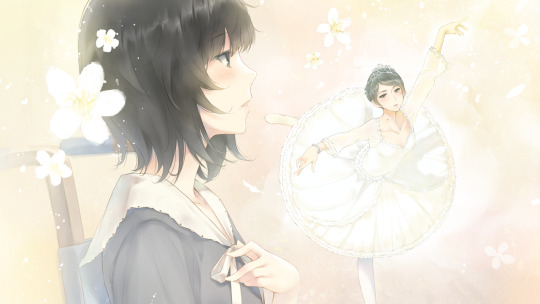
(FLOWERS -Le volume sur ete-)
They are gay. Thank you for coming to my VNConf talk.
-
You can similarly abstract characters.
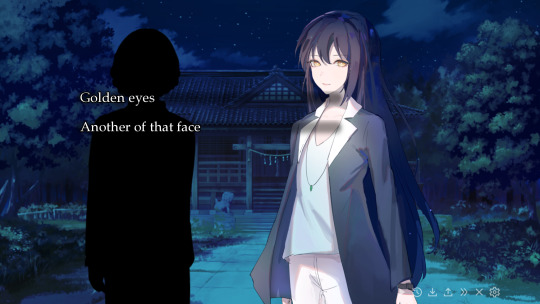
(Lachesis or Atropos)
Consider representing irrelevant characters (e.g., NPCs) as silhouettes. The reader can fill in the details within the shapes themselves.
Silhouettes are especially great for crowd scenes where you want to draw focus to the main characters.
This will be a recurring theme:
What do you really need to draw?
-
II. Cut-ins
One common not-quite full screen piece of art you'll see in many visual novels is the cut-in.
The cut-in typically consists of the:
Item/focus
Frame
And is often for topics such as objects or small animals, which may exist in the scene but may not be within the same frame of reference as the background and sprites.
The separate framing informs the players that the item is "separately framed."
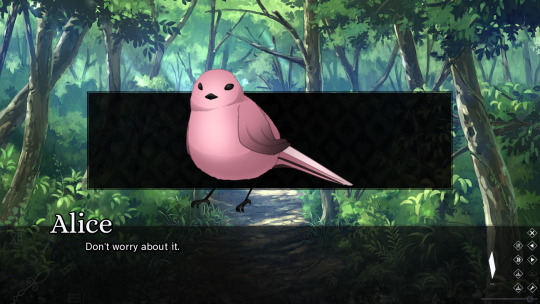
(Who is the Red Queen?)
For example, this small bird is not huge and would not be the size of a character's head even had a sprite been on screen.
The Foreground-Backdrop Heuristic
Cut-ins make strong use of what I refer to as the "foreground-backdrop heuristic."
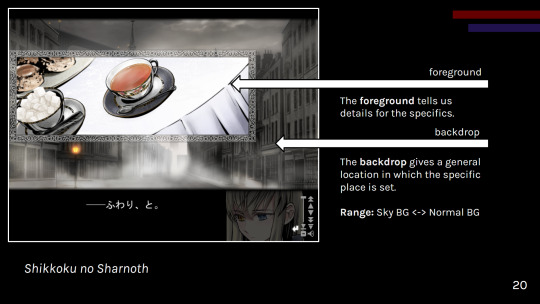
(Shikkoku no Sharnoth)
A general backdrop informs the reader of a broad location or scene (especially if characters are present). Then a more specific foreground (the cut-in) informs the reader of the specifics.
As the foreground cut-in is in a different frame, the pairing of the two helps create a mental model of the space in the reader's mind.
Cut-ins can be used for:
Backgrounds (mix and match foregrounds with a backdrop)
Reduced CGs
Presenting existing assets in a different frame of reference
CG variants
Try tackling your visual presentation in a layered, comic book-esque fashion with cut-ins!
Just be careful about clutter.
Whether you want to go for the layered cut-in style, the 3d stage cinematic style, or a combination of the two, make sure you have a vision before you jump in.
SD CGs
I had to make an obligatory mention of SD "super deformed" CGs in this talk, so here it is in the write up as well.
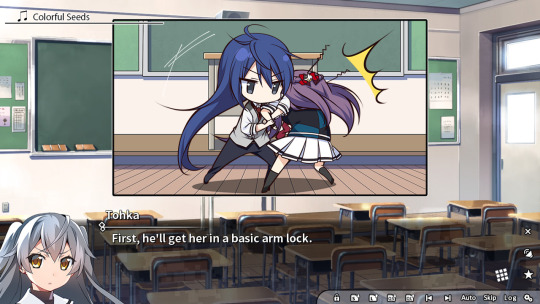
(Grisaia: Phantom Trigger Vol. 1)
SD, chibi. However you call these, they're great for playful scenes that might require more art than your classic sprite-background combination.
What SD CGs do best is that they:
Fulfill the role of a CG
Are easier to draw than fully rendered non-chibi art
Can be distributed to different artists to reduce artist workloads due to style difference
Just keep in mind that a simplified CG is still a CG and thus may lack reusability.
Consider what scenes really need a CG.
-
III. Reduce
Now, consider asking yourself: "Does what a player does not see need to exist?" (mostly applicable for games with opaque UI)
Yet, what you need to draw is what you need to draw. How can you reduce the work in what you need to draw?
One option is:
Palette Limitation
You've heard of gray scale games, but don't forget about other ways of limiting your palette to reduce workload.
Dramatic, mood setting color power
Less rendering work
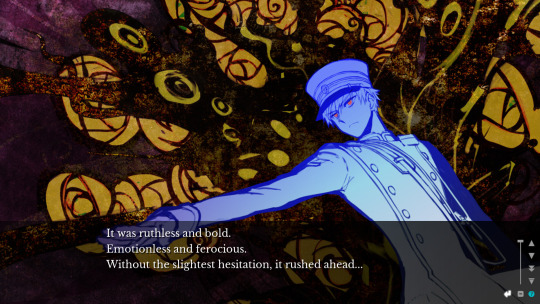
(Sona-Nyl of the Violet Shadows)
A similar idea can be applied to NPCs for a more detailed take on silhouettes.
-
IV. Reuse
Lastly, please remember to be economical and reuse assets as necessary. One of the great joys of cut-in BGs, for example, is reusability.
I had to give an obligatory mention to CG variants in my talk, such as:
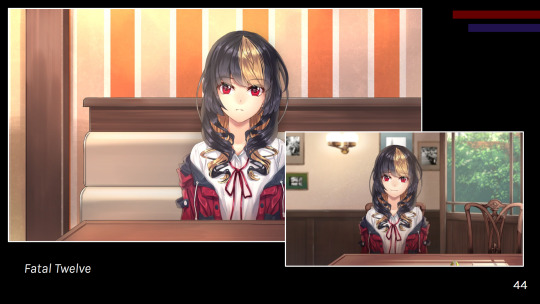
(Fatal Twelve)
However, overall, you never know when you'll want to use various components of your art elsewhere such as intermixing CG and sprite art.
Please keep your working layers if possible.
Other reuse examples:
UI (especially in episodic games)
Gameplay (e.g., Kogado's rhythm game)
Consider asking your programmer to work on a framework to reuse, reducing repeated code work.
-
Conclusions
All in all, you can make your game.
And it doesn't need to be hellish on your budget or timeline.
If you take anything away from this talk, let it be to:
Prioritize reusable assets
Maintain aesthetic; avoid clutter
Display important scenes
Do not scope up; aim for a set goal
A scene can be presented in many stylish ways, some of which will suit your workflow better than others.
So, go on. Make your game!
-
Interested in my works? Find me on itch:
And check out my newsletter:
-
VNConf 2023 Talk Write-up:
#visual novel development#vnconf#visual novel#vn#vndev#development guide#devlog#game development#talk write-up#gamedev#indiedev#this talk is also a yuri visual novel recommendation (kind of)#lachesis or atropos#shiei no sona-nyl#fatal twelve#grisaia phantom trigger#shikkoku no sharnoth#flowers visual novel#who is the red queen?
55 notes
·
View notes
Text
Chapter 38:
Ripples in the Water

Elena had spent all day telling herself she wasn’t nervous.
She had picked out her outfit the night before, packed her meal, double-checked her bag to make sure she had a fresh notebook and two pens—one as a backup, just in case.
She had taken the bus after school, giving herself enough time to get a coffee and breathe before walking into the office.
But now, standing outside DynaCore Solutions, she felt her stomach tighten anyway.
This was her first real job.
A foot in the door. A chance to prove herself.
No pressure.
She exhaled sharply, then squared her shoulders.
She could do this.
She would do this.
And so—she walked inside.
⋆。˚❀˚。⋆。˚❀˚。⋆。˚❀˚。⋆。˚❀˚。⋆
The office was modern, bright, buzzing with energy.
No sterile cubicles, no drab carpets. Just glass walls, sleek desks, and a quiet, focused hum of productivity.
People moved through the space with purpose, typing furiously at their computers, answering calls, collaborating in glass-walled conference rooms.
Elena’s heels clicked against the polished floors as she made her way to the front desk.
A receptionist greeted her with a smile. “You must be Elena. First day, right?”
Elena nodded. “Yeah. Executive assistant to Ryan Cho.”
The receptionist grinned. “Good luck. He moves fast.”
Elena’s stomach flipped.
Great.
⋆。˚❀˚。⋆。˚❀˚。⋆。˚❀˚。⋆。˚❀˚。⋆
Ryan Cho, Head Stack Developer, was exactly as advertised.
Young, confident, too busy to waste time.
He didn’t offer a long-winded welcome speech.
Instead, the second she stepped into his office, he glanced up from his laptop and said, “I need someone who can keep up. Can you keep up?”
Elena stood straighter. “Yes.”
Ryan nodded. “Good.”
Then, without missing a beat, he launched into an overview of her tasks, rattling off meeting schedules, deadlines, priority projects, and internal tools she’d need to learn.
Elena scrambled to write everything down, her pen flying across the page.
She barely had time to process one task before another followed.
Halfway through, Ryan paused.
“You’re writing all of this down?”
Elena looked up. “Of course.”
Ryan’s mouth ticked up slightly, like he was impressed.
“Good,” he said. Then he kept going.
⋆。˚❀˚。⋆。˚❀˚。⋆。˚❀˚。⋆。˚❀˚。⋆
The afternoon was relentless.
Ryan had her proofreading reports, scheduling meetings, compiling project updates, and learning new software tools on the fly.
It wasn’t overwhelming, exactly.
But it was fast.
Every time she finished something, there was something else waiting.
There was no small talk, no wasted time—just efficiency and focus.
By 4pm, her hand ached from writing.
But she wasn’t drowning.
She was keeping up.
And that?
That felt like a win.
⋆。˚❀˚。⋆。˚❀˚。⋆。˚❀˚。⋆。˚❀˚。⋆
When it was her break time, she retreated to a quiet corner of the office and pulled out the meal she had packed the night before.
She barely had time to take a bite before someone sat across from her.
“Smart move,” a voice said.
Elena looked up.
A woman, about thirty, with a confident smirk and sharp eyes, leaned forward on her elbows.
“Packing your own,” she clarified. “First day, no time to run out and grab food. Shows you’re prepared.”
Elena swallowed her bite. “It’s also just cheaper.”
The woman chuckled. “Also smart. I’m Gurpreet, by the way. Senior UI designer.”
Elena straightened. “Elena. Executive assistant to Ryan.”
Gurpreet raised an eyebrow. “Damn. Tough gig.”
Elena smirked. “I’m keeping up.”
Gurpreet studied her, then nodded, approving.
“Good,” she said. “Ryan’s picky about who he works with. If he’s not complaining, you’re doing fine.”
Elena exhaled. That was… reassuring.
She took another bite, and for the first time all day, she let herself breathe.
⋆。˚❀˚。⋆。˚❀˚。⋆。˚❀˚。⋆。˚❀˚。⋆
By the time the evening rolled around, she had gotten a feel for the hierarchy.
Ryan wasn’t the CEO, but he was still high up enough that she had to be careful.
She noticed how different teams interacted—developers worked directly with him, while others went through her first.
People were friendly, but no one wasted time with casual chit-chat.
This wasn’t school.
This was work.
And if she wanted to succeed, she had to earn it.
⋆。˚❀˚。⋆。˚❀˚。⋆。˚❀˚。⋆。˚❀˚。⋆
At exactly 7:47 PM, Ryan finally looked up from his screen.
“Good work today,” he said simply.
Elena blinked. “Oh. Thank you.”
Ryan nodded. “You picked things up fast.”
Elena grinned, despite herself.
Maybe this job wasn’t impossible after all.
She closed her notebook, tucking it under her arm.
“Same time tomorrow?” she asked.
Ryan smirked. “Hope you bring another notebook.”
Elena laughed, heading for the door.
She had survived her first day in the real world.
And she was ready for whatever came next.
⋆。˚❀˚。⋆。˚❀˚。⋆。˚❀˚。⋆。˚❀˚。⋆
#bookblr#books and reading#lesbian#lgbtqia#novel#novel writing#transgender#wlw#book blog#transbian#transfem#wlw books#coming of age#romance#fiction#sapphic#wlw post#trans joy#trans fem#mtf trans#trans identity#transgirl#trans beauty#trans life#trans woman#trans pride#trans people#trans community#trans rights#trans visibility
9 notes
·
View notes